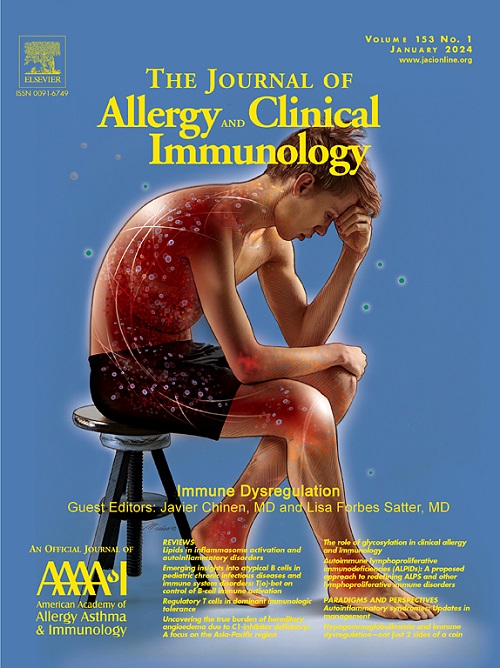Inborn errors of immunity reveal molecular requirements for generation and maintenance of human CD4+ IL-9–expressing cells
IF 11.4
1区 医学
Q1 ALLERGY
引用次数: 0
Abstract
Background
CD4+ T cells play essential roles in adaptive immunity. Distinct CD4+ T-cell subsets—TH1, TH2, TH17, TH22, T follicular helper, and regulatory T cells—have been identified, and their contributions to host defense and immune regulation are increasingly well defined. IL-9–producing TH9 cells were first described in 2008 and appear to play both protective and pathogenic roles in human immunity. However, key requirements for generating human TH9 cells remain incompletely defined.
Objective
We sought to define signaling pathways that regulate IL-9 production by human CD4+ T cells.
Methods
Human naive and memory CD4+ T cells were cultured under different conditions, and the molecular mechanisms regulating IL-9 induction were determined by assessing the ability of CD4+ T cells from a broad range of patients (n = 92) with pathogenic variants in key immune genes (n = 21) to differentiate into IL-9+ cells.
Results
We identified 2 culture conditions that yielded IL-9–expressing cells from naive CD4+ T cells and amplified IL-9 production by in vivo–generated memory CD4+ T cells: TGF-β plus IL-4 (ie, TH9 polarizing condition), and the combination of IL-21, IL-23, IL-6, IL-1β, and TGF-β (ie, TH17 polarizing condition). Combining these conditions had a synergistic effect in generating IL-9+CD4+ T cells. IL-9 induction required STAT3-activating cytokines as well as intact signaling via the T-cell receptor and STAT5. Importantly, IL-9 induction was restrained by IFN-γ/STAT1 and IL-10.
Conclusions
Our findings revealed critical molecules involved in inducing/restraining IL-9 production by human CD4+ T cells, thereby identifying pathways that could be targeted to modulate IL-9 in health and disease.
先天免疫缺陷揭示了人类IL-9表达细胞产生和维持的分子需求。
背景:CD4+ T细胞在适应性免疫中起重要作用。不同的CD4+ T细胞亚群- Th1, Th2, Th17, Th22, T滤泡辅助T细胞和调节性T细胞-已经被确定,它们对宿主防御和免疫调节的贡献越来越明确。产生IL-9的Th9细胞于2008年首次被描述,似乎在人类免疫中发挥保护和致病作用。然而,产生人类Th9细胞的关键条件仍未完全确定。目的:明确调节人CD4+ T细胞产生IL-9的信号通路。方法:在不同条件下培养人初始CD4+ T细胞和记忆CD4+ T细胞,通过评估关键免疫基因(n=21)致病变异患者(n=92) CD4+ T细胞向IL-9+细胞分化的能力,确定调节IL-9诱导的分子机制。结果:我们确定了两种培养条件,可以从naïve CD4+ T细胞中获得表达IL-9的细胞,并通过体内产生的记忆性CD4+ T细胞扩增IL-9: TGFβ + IL-4(即Th9极化条件),以及IL-21、IL-23、IL-6、IL-1β和TGFβ(即Th17极化条件)的组合。结合这些条件在产生IL-9+CD4+ T细胞方面具有协同作用。IL-9的诱导需要激活stat3的细胞因子以及通过TCR和STAT5的完整信号传导。重要的是,IFNγ/STAT1和IL-10抑制了IL-9的诱导。结论:我们的研究结果揭示了参与诱导/抑制人类CD4+ T细胞产生IL-9的关键分子,从而确定了可能在健康和疾病中靶向调节IL-9的途径。
本文章由计算机程序翻译,如有差异,请以英文原文为准。
求助全文
约1分钟内获得全文
求助全文
来源期刊
CiteScore
25.90
自引率
7.70%
发文量
1302
审稿时长
38 days
期刊介绍:
The Journal of Allergy and Clinical Immunology is a prestigious publication that features groundbreaking research in the fields of Allergy, Asthma, and Immunology. This influential journal publishes high-impact research papers that explore various topics, including asthma, food allergy, allergic rhinitis, atopic dermatitis, primary immune deficiencies, occupational and environmental allergy, and other allergic and immunologic diseases. The articles not only report on clinical trials and mechanistic studies but also provide insights into novel therapies, underlying mechanisms, and important discoveries that contribute to our understanding of these diseases. By sharing this valuable information, the journal aims to enhance the diagnosis and management of patients in the future.

 求助内容:
求助内容: 应助结果提醒方式:
应助结果提醒方式:


